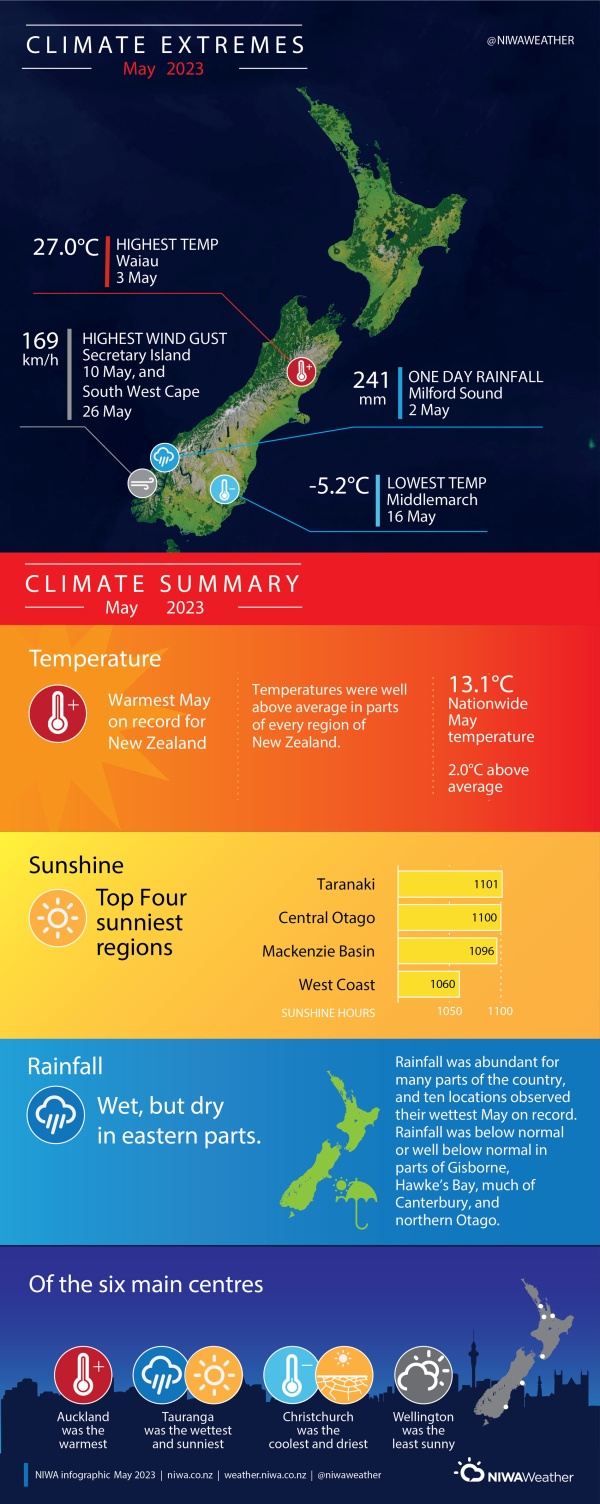Warmest May on record
|
Temperature |
Temperatures were well above average (>1.20°C above average) for most of the country, and at least 2°C higher than average in parts of every region, except for Northland. |
|
Rainfall |
Rainfall was above normal (120-149% of normal) or well above normal (>149% of normal) for Northland, Auckland, Waikato, Bay of Plenty, Taranaki, parts of Manawatū-Whanganui, Wellington, Tasman, Nelson, northern Marlborough, West Coast, inland Otago and western Southland. Rainfall was below normal (50-79% of normal) or well below normal (<50% of normal) in parts of Gisborne, Hawke’s Bay, much of Canterbury, and northern Otago. |
|
Soil Moisture |
At the end of May, soils were wetter than normal for parts of Gisborne, Manawatū-Whanganui, northern Marlborough, eastern Canterbury near Christchurch, and inland Otago. Drier than normal soils were prominent for coastal parts of North Otago and South Canterbury. |
Overview
It was the warmest May on record in Aotearoa New Zealand. The nationwide average temperature in May 2023 was 13.1°C. This is 2.0°C above the 1991-2020 May average from NIWA’s seven station temperature series which begins in 1909. Of the five warmest Mays on record, all have occurred since 2011. May 2023 mean sea level air pressure (MSLP) was lower than normal over the Tasman Sea, and higher than normal east of New Zealand. Overall, this resulted in more northerly and northeasterly airflows than usual over much of the country. The first eight days of the month were exceptionally warm for the time of year, and dozens of locations observed record or near-record high daily maximum and minimum temperatures during this period (see Highlights and extreme events for further details). The warmth persisted for the month overall, and monthly temperatures were above average (0.51-1.20°C above average) or well above average (>1.20°C above average) in every region of New Zealand.
It was the second warmest May on record in terms of sea surface temperatures near the South Island, where a marine heatwave delayed the seasonal transition to colder temperatures. The widespread nature of May’s exceptional warmth, both on land and in the sea, have been exacerbated by climate change.
May rainfall was abundant for many parts of the country, with above normal (120-149% of normal) or well above normal (>149% of normal) totals observed in Northland, Auckland, Waikato, Bay of Plenty, Taranaki, parts of Manawatū-Whanganui, Wellington, Tasman, Nelson, northern Marlborough, West Coast, inland Otago and western Southland. The wettest locations compared to normal were Kaikohe, Rotorua, and Motueka, which recorded 377%, 342%, and 206% of normal May rainfall, respectively. In contrast, rainfall was below normal (50-79% of normal) or well below normal (<50% of normal) in parts of Gisborne, Hawke’s Bay, much of Canterbury, and northern Otago. It was particularly dry in Oamaru, where just 24 mm of rainfall (32% of normal for May) was recorded.
Further Highlights:
- The highest temperature was 27.0°C, observed at Waiau on 3 May.
- The lowest temperature was -5.2°C, observed at Middlemarch on 16 May.
- The highest 1-day rainfall was 241 mm, recorded at Milford Sound on 2 May.
- The highest wind gust was 169 km/h, observed at Secretary Island on 10 May, and South West Cape on 26 May.
- Of the six main centres in May 2023, Auckland was the warmest, Tauranga was the wettest and sunniest, Christchurch was the coolest and driest, and Wellington was the least sunny.
- Of the available, regularly reporting sunshine observation sites, the sunniest four locations in 2023 so far are Taranaki (1101 hours), Central Otago (1100 hours), Mackenzie Basin (1096 hours) and West Coast (1060 hours).


